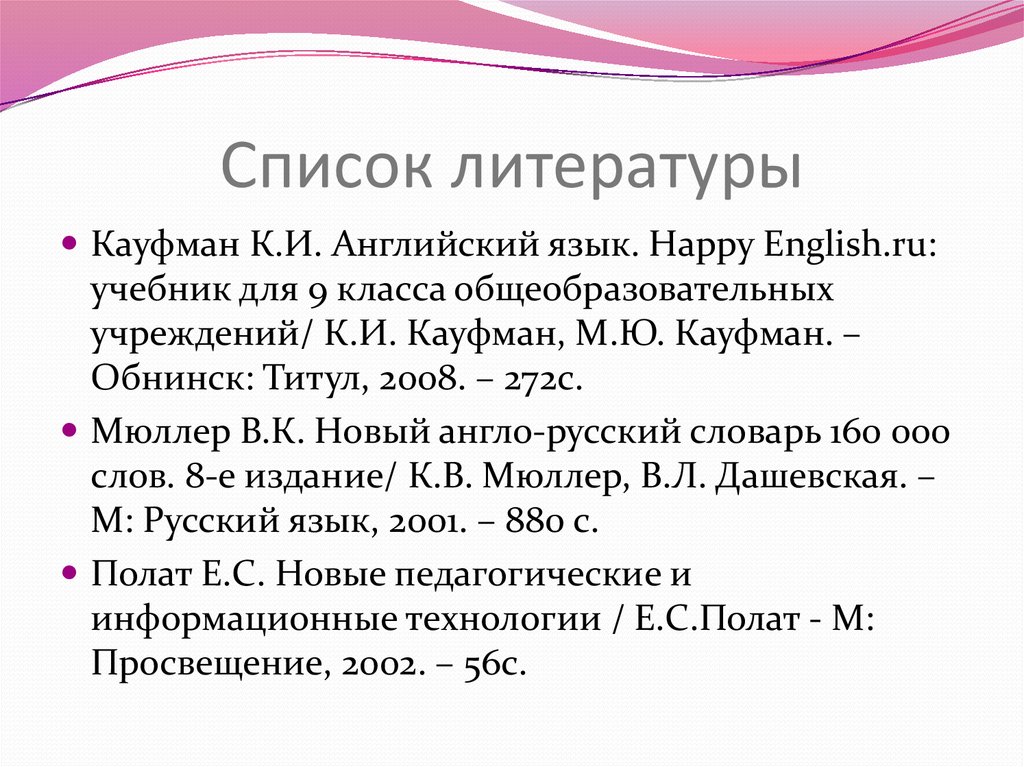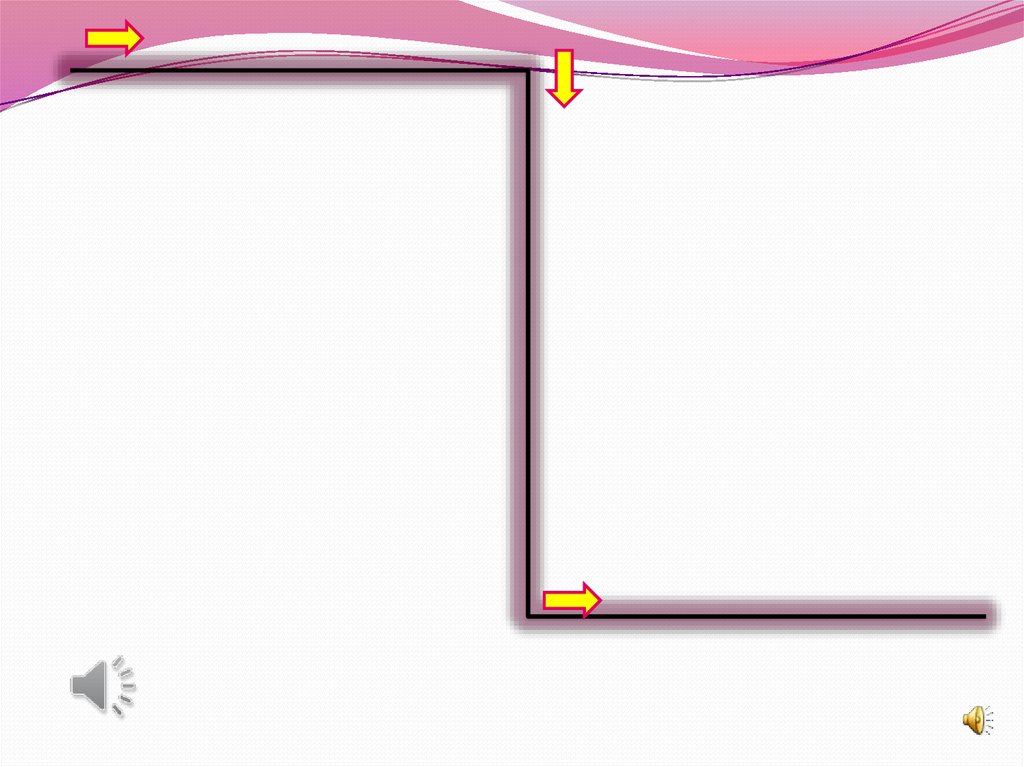Похожие презентации:
Использование технологии проектирования на среднем этапе обучения английскому языку
1. Рыжова Ольга Александровна
Учитель английскогоязыка в МОУ ИРМО
«Оёкская
средняя
общебразовательная
школа»
I квалификационная
категория
2. Использование технологии проектирования на среднем этапе обучения английскому языку
Цель:Повышение мотивации учащихся 7-9 классов в обучении
английскому языку
Задачи:
1. Изучение теоретического материала
2. Подбор материала по интересующим темам c
использованием УМК Кауфман К.И. Happy English.ru
3. Создание и защита проектов по заданным темам
4. Использование проектов в учебной и внеурочной
деятельностях, на конференциях, в конкурсах…
3. Темы проектов в 9 классе
На урокахВнеурочные
Visiting New York
Start a film review club
Youth subcultures
Differences between BE and
AE
Your fashion preferences
Your healthy lifestyle
The letter to Santa Claus
4. Типы проектов
Исследовательский проектИнформационный проект
Прикладной (практико-ориентированный) проект
Творческий проект
Ролевые, игровые, приключенческие проекты
По предметно-содержательной области
Монопредметный проект
Межпредметный проект
Надпредметный проект
5. Проекты в виде
Презентации Power PointБрошюры, раскладушки
На листах формата А4, А3
Видеофильмы
6. Практическая реализация
Дальнейшее использование проектов в урочной ивнеурочной деятельности
Выступления на НПК
Письмо Санте – nic-snail.ru
Личные письма - Rosetta Stone LTD. 135 West Market
Street, Harrisonburg VA 22801, USA
www.sharedtalk.com
7. The differences between British English and American English Bortnevskaya Yuliya
8. Aim:
Find the connection and differencesbetween American and British English,
consider the characteristics of each
variant of the language and to identify
options for the use of languages in the
literature of foreign authors.
9. The history of British language
10. The history of American language
In XVII-XVIII centuries in America (New World), the crowd surged immigrantsrepresented the French, Spanish, German, Dutch, Norwegian and even Russian.
But most of them were from England (the British Isles as a whole, this is
Scotland, and Wales), where it was said in English
11. Differences in spelling
SAESBE
color
colour
center
centre
сheck (noun)
cheque (noun)
defense / license / practise
defence / licence / practice
all right
alright
maneuver
manoeuvre
tire
tyre
aging
ageing
whiskey (U.S. & Ireland)
whisky (Scottish)
12. Differences in vocabulary
Британскийflat
lawyer
luggage
milliard
cab
company
city/town centre
chemist's
lift
autumn
petrol
motorway
cross-roads
living room
coach
post
cinema
trousers
sleeper
railway
shop-assistant
Американский
apartment
attorney
baggage
billion
taxi
corporation
downtown
drugstore
elevator
fall
gas
highway
intersection
drawing room
long-distance bus
movies
pants
Pullman
railroad
saleman, clerk
13. Differences in punctuation
SAESBE
Date writing, number/word order. (Never use only numbers!)
month/day/year
12/03/03
December 3, 2003
day/month/year
12/03/03
March 12, 2003
Use of commas and periods inside/outside quotation marks.
He said, "I love you."
He said, 'I love you'.
Business letter salutations, colons vs commas.
Dear Mr. Jones:
Dear Mr Jones,
'Honorifics': Mr. or Mrs. or Dr. Smith (U.S.) vs Mr or Mrs or Dr Smith (GB), etc.
Mr. Smith
Mrs. Brown
Dr. Wolf
Mr Smith
Mrs Brown
Dr Wolf
14. Differences in grammar
SAESBE
The Government is acting
like itself again.
The Government are acting
like themselves again.
We lived on Main Street.
We lived in the High Street. (cf. 'street
people' ...)
I didn't tell him about my new job yet.
I haven't told him about my new job
yet.
He's in the hospital with a broken leg. He's in hospital with a broken leg.
I'm hungry. I gonna have lunch.
I'm hungry. I am going to have lunch.
15. Differences in phonetics
WordSAE Pronunciation
SBE Pronunciation
advertisement
'æd vз:r ta z mənt
əd'vз: t smənt
controversy
'ka:n trə vз:r si
'k n trə vз: si
kən'tr v əsi
laboratory
'læb rə t r i
lə'b r ə tri
secretary
'sek rə ter i
'sek rə tri
leisure
'le ər
'le ə
schedule
'sked ju:l
' ed ju:l
dynasty
'da nə sti
'd n ə sti
dance
dænts
da:nts
oregano
'reg ə no
r 'ga: nə
clerk
klз:rk
kla:rk
ate
et
et
ballet
bæ'lei
'bæ lei
16.
17. The use of these languages in the literature as an example of an American author
The use of these languages in the literatureas an example of an American author
J. London “White Fang”
” There is only six now”, he said.
“You an` me a-sittin by the fire”
“Takes more`n a handful of them pesky critters to do
for yours”
18.
19. The use of these languages in the literature as an example of the British author
The use of these languages in the literatureas an example of the British author
William Shakespeare “Hamlet”
There`s, That`s, It`s, I`ll, We`ll, I`d, You`re
‘Ay , sir, to be honest, as this world goes, is to be one
man picked out of ten thousand’
‘My Lord, what do you read?’
20. Conclusion
In this study we examined the differences of BritishEnglish and American English languages and the
application of these languages in the literature. As a
result, we found that more and more popular in our time
is American English, as it is considered easier to
remember. As for fiction writers of the United States,
American English is fully preserved only in direct speech.
But this does not mean that the British version has
ceased to apply. British English is the "language of kings."
Beautiful, correct and concise.
21. Не забывайте про здоровьесберегающие технологии на уроках
Смена видов деятельностиЭмоциональные разрядки
Физминутки
22. Список литературы
Кауфман К.И. Английский язык. Happy English.ru:учебник для 9 класса общеобразовательных
учреждений/ К.И. Кауфман, М.Ю. Кауфман. –
Обнинск: Титул, 2008. – 272с.
Мюллер В.К. Новый англо-русский словарь 160 000
слов. 8-е издание/ К.В. Мюллер, В.Л. Дашевская. –
М: Русский язык, 2001. – 880 с.
Полат Е.С. Новые педагогические и
информационные технологии / Е.С.Полат - М:
Просвещение, 2002. – 56с.





























 Английский язык
Английский язык Образование
Образование








